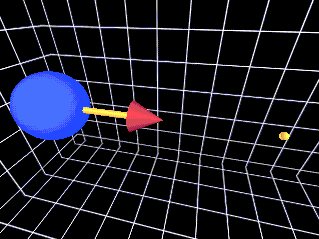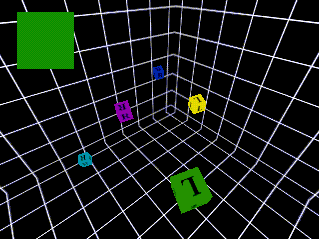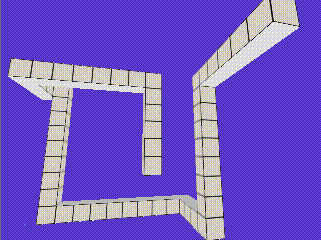Evaluation of Virtual Travel Techniques
In this project, we hope to categorize and evaluate methods used for
travel in three-dimensional, immersive virtual environments.
Our focus is limited to virtual (not physical) motion with a first
person point-of-view.
We have created a taxonomy of techniques, based on three components
which must be addressed in any virtual travel method:
- Direction/Target Selection
- Velocity/Acceleration Selection
- Conditions of Travel (input required)
We have also created a partial list of quality factors which may be
important to the designers of virtual travel techniques. These include:
- Speed to target
- Accuracy of reaching target
- Amount of user disorientation
- Amount of cognitive load required for use
- Ability to gather information while travelling
- Feeling of presence within the environment while travelling
Since most, if not all, of these quality factors are measurable,
we have proposed a series of experiments to evaluate the utility
of various techniques or components of techniques with respect
to these factors. In particular, we do not propose to find the
"best" technique overall, or even the best technique for a given
application. Rather, we measure a technique's "score" for one or
more of the quality factors, and allow application developers to decide
the weight given to each factor.
So far, we have conducted four experiments within our evaluation
framework:
1. Relative Motion Test

The user moves relative to the pointer in the left of the
picture to the spot denoted by the sphere at right. The sphere
is not visible during the trials.
We measure the usefulness of a technique for moving to a point in
space relative to an object. In particular, we are testing
gaze-directed direction selection vs. direction selection via
pointing.
2. Disorientation due to velocity/acceleration

After travel, the user must find the
cube whose color matches the stimulus in the upper left corner.
The goal is to obtain a measure of the amount of directional
disorientation due to the velocity and/or acceleration of travel.
Four techniques are used:
- Constant, slow velocity
- Constant, fast velocity
- Slow-in, slow-out acceleration
- Jumping (infinite velocity)
3. Speed to target characterization
By varying the distance to and the size of the target, we can
simultaneously measure speed and accuracy, in a manner similar
to Fitts' Law. We are examining two factors here: gaze vs. pointing
and constrained vs. unconstrained motion.
4. Information Gathering characterization

The user's view inside the corridor.

An outside view of a 3-Dimensional corridor.
Subjects traveled through 1-, 2-, and 3-dimensional corridors, collecting
information (words and locations) as they moved. We studied not only
travel technique (gaze-directed, pointing, torso-directed), but also
the use of collision detection, and the dimensionality of the travel
path.
Project Participants:
Doug Bowman
David Koller
Publications:
Bowman, D., Koller, D., and Hodges, L., "A Methodology for the
Evaluation of Travel Techniques for Immersive Virtual Environments,"
currently submitted to PRESENCE.
Download a PostScript Version of the paper
Bowman, D., Koller, D., and Hodges, L., "Travel in Immersive
Virtual Environments: An Evaluation of Viewpoint Motion
Control Techniques,"
in the Proceedings of the Virtual Reality Annual International
Symposium (VRAIS), 1997.
View the
Abstract
Download a PostScript Version of the paper
Contact Information:
Doug A. Bowman - Graduate Student
Georgia Institute of Technology
College of Computing
Atlanta GA 30332-0280
(404) 894-5104 (Phone)
By E-MAIL :
bowman@cc.gatech.edu




